Montgomery, Alabama, Hgh State Clinic, Hgh Injections, Hrt Doctors
Montgomery, Alabama Blood Testing Facilities
 Represents a LabCorp blood testing facility
Represents a LabCorp blood testing facility Represents a Quest Diagnostics blood testing facility
Represents a Quest Diagnostics blood testing facility

Nearby Labcorp Blood Testing facilities:
- Labcorp Center Distance: 1 m, 1722 Pine Street Suite 601, Montgomery, Montgomery County, AL, 36106
- Labcorp Center Distance: 4 m, 4135 Atlanta Hwy Suite Z, Montgomery, Montgomery County, AL, 36109
- Labcorp Center Distance: 7 m, 225-A Winton Blount Loop, Montgomery, Montgomery County, AL, 36117
- Labcorp Center Distance: 43 m, 103 Samuel O Moseley Dr, Selma, Dallas County, AL, 36701
- Labcorp Center Distance: 53 m, 1518-B Professional Pkwy, Auburn, Lee County, AL, 36830
- Labcorp Center Distance: 54 m, 209 W Spring St Suite 105, Sylacauga, Talladega County, AL, 35150
- Labcorp Center Distance: 71 m, 153 Narrows Pkwy Ste 202, Birmingham, Shelby County, AL, 35242
- Labcorp Center Distance: 78 m, 1345 13Th Street Suite R, Columbus, Muscogee County, GA, 31901
- Labcorp Center Distance: 79 m, 2022 Brookwood Medical Ctr Dr Ste 401, Birmingham, Jefferson County, AL, 35209
- Labcorp Center Distance: 82 m, 790 Montclair Road, Birmingham, Jefferson County, AL, 35213
- Labcorp Center Distance: 85 m, 1600 Vernon Rd Suite D, Lagrange, Troup County, GA, 30240
- Labcorp Center Distance: 91 m, 902 Dr Edward Hillard Dr., Tuscaloosa, Tuscaloosa County, AL, 35401
- Labcorp Center Distance: 93 m, 1412 Leighton Ave, Anniston, Calhoun County, AL, 36207
- Labcorp Center Distance: 94 m, 2217 Decatur Hwy, Gardendale, Jefferson County, AL, 35071
- Labcorp Center Distance: 97 m, 1034 Ross Clark Cir, Dothan, Houston County, AL, 36303
Nearby Quest Blood Testing facilities:
- Quest Center Distance: 8 m, 7065 Sydney Curve, Montgomery, Montgomery County, AL, 36117-7101
- Quest Center Distance: 77 m, 1629 10Th Ave Ste B, Columbus, Muscogee County, GA, 31901-3520
- Quest Center Distance: 80 m, 513 Brookwood Blvd, Suite 506, Birmingham, Jefferson County, AL, 35209-6892
- Quest Center Distance: 92 m, 300 Towncenter Blvd, Tuscaloosa, Tuscaloosa County, AL, 35406-1842
Hormone Replacement Services in Alabama
The Conscious Evolution Institute provides Physician-Monitored Bio-Identical Hormone Replacement Therapy to all corners of Alabama, as well as all counties in the United States. Although we are not located in the state of Alabama, we have affiliate medical professionals all across the state that perform services on our behalf so that we may provide quality Hormone Replacement Products cost effectively and reliably to meet the needs of our customers all across the nation.
Quality Hormone Treatments Start with a Single Phone Call!
We make it easy at the Conscious Evolution Institute. All it takes is a single phone call to get things rolling. We will ask you some questions about your personal and family medical history and set you up with an appointment with one of our affiliate physicians for a physical and blood sample. This is all we physically need from you in order to remotely provide a full diagnostic evaluation.
You don't even have to visit the doctor's office! We can arrange for our affiliate doctor to come to your home or business to perform the entire process. He or she will provide a full physical evaluation and take a simple blood sample and that's it. We can have everything done in less than a half hour
After the doctor takes your blood sample, he or she will ship the sample to LabCorp, the nation's most trusted blood diagnostic testing company. They will perform a full diagnostic blood panel on your sample, which will measure everything from your cholesterol to your Testosterone Levels to your Red Blood Cell Count in order to provide our medical professionals with a full overview of your health and hormone status.
This whole process takes around a week, after which your appointed personal physician will receive the results, interpret them in order to consider the best course of action to improve your health and hormone balance, and contact you to discuss potential treatment options. Once you and your physician agree upon what treatment is right for you, he or she will write a prescription and you can have the treatment mailed directly to your door! It's that easy!
Testosterone Replacement Therapy in Alabama
One of the treatment options we provide is Bio-Identical Testosterone Replacement Therapy. For men, Testosterone is an incredibly important hormone. It encourages the formation of muscle mass and wards off fat. It is responsible for both the male libido and the ability to engage in sexual activity. The problem with Testosterone is that the body makes less of it over time, or as a result of certain lifestyle choices.
Testosterone Levels peak during adolescence and remain high throughout early adulthood, until the late twenties, on average. Starting in the late twenties, Testosterone Levels start to slowly decline for reasons that scientists are only beginning to understand. What they do understand, however, is that Testosterone Deficiency both depresses quality of life and increases mortality risk for men as it becomes more severe.
As Testosterone Levels start to decline, you likely won't experience any symptoms for many years, but by the time you reach your forties or fifties, you may start to experience significant symptoms such as fatigue, loss of sex drive, and an increase in bodyfat. Here are some of the symptoms of Testosterone Deficiency:
Fatigue
Unexplained Weight Gain
Unexplained Loss of Muscle Mass
Loss of Sex Drive
Impotence
Anxiety
Depression
Osteoporosis
Trouble Sleeping
If you are experiencing some of these symptoms, especially if you are experiencing symptoms related to sexual desire and function, there is a significant chance that you are suffering from Testosterone Deficiency. Our diagnostic evaluation can help discern the root cause of your medical condition, and decide if Testosterone Therapy is right for you.
Types of Testosterone Replacement
If we do find that you qualify for Testosterone Treatment, we have a multitude of options available that can meet your medical needs while also meeting your budget and your personal preferences. Here are some of the options we have available for you:
Testosterone Injections
Testosterone Patches
Testosterone Gels
Testosterone Implants
Testosterone Topical Sprays
Testosterone is also important for women, as it has a powerful impact on bone health and sex drive among other factors. We also have Testosterone Therapy options available for women struggling with menopause or that want to preserve their health and sex drive during or after menopause.
Human Growth Hormone Replacement Therapy in Alabama
Another medical service we provide is Bio-Identical HGH Therapy. Human Growth Hormone is vitally important for both sexes. During childhood and adolescence, Growth Hormone is responsible for growth and development and leads to the significant change in height associated with puberty. After puberty, HGH Levels decline to a level intended to preserve normal health and function.
Human Growth Hormone stimulates cellular metabolism, which impacts all systems in the body, keeping the body healthy by stimulating the growth of cells so that the body is able to replace old cells at a rate sufficient to maintain normal health and function. Starting around the age of thirty, however, the brain starts to slowly signal for less and less of the hormone over time, which, over the course of years and decades, can have a negative impact on health and human function.
If you are experiencing three or more of the following symptoms and you are over the age of thirty, you may be experiencing HGH Deficiency:
Increase in Fat Around the Midsection
Fatigue
Slow Healing from Injury
Weakened Immune System
Prematurely Aging Skin
Loss of Muscle Mass
Depression
Loss of Sex Drive
Poor Sleep
Memory Issues
General Cognitive Decline
Types of HGH Replacement Treatment
If you qualify for Physician-Monitored HGH Replacement Therapy, we can have HGH Injections or Sermorelin Acetate Injections sent straight to your door. Unfortunately, unlike Testosterone Replacement Therapy, the only effective means to replace Human Growth Hormone is through injection. The good thing is that these injections are delivered just under the skin and are relatively painless, so there's no need to be afraid to try the therapy.
Both Bio-Identical HGH and Functionally-Identical Sermorelin are effective at relieving the condition of Human Growth Hormone Deficiency safely, but do so through different mechanisms. HGH Injections replace Growth Hormone directly, replacing that which the human body no longer produces effectively. Sermorelin Acetate works by helping the human body make its own Growth Hormone, supplementing signals sent by the brain to encourage healthy production.
HCG Weight Loss Therapy in Alabama
Are you overweight or obese and have not been able to meet any of your weight loss goals? There are few conditions that are more dangerous for your long term health than obesity. Your risk of heart disease and other cardiovascular conditions increases significantly with every year that you remain significantly overweight.
Human Chorionic Gonadotropin Weight Loss Therapy is an effective means for men and women to lose as much as a pound a day in order to rapidly burn unhealthy adipose fat and improve the health and physical appearance of the body. HCG Injections are combined with a significantly low calorie diet in order to encourage the body to burn fat in a healthy way while also warding off feelings of hunger and discomfort.
HCG has the unique ability to suppress feelings of hunger associated with dieting, making it easier to stay on track and meet weight loss goals. HCG is also effective in combination with diet because it encourages the body to burn adipose fat stores which accumulate around the waist, hips, and midsection, the toughest fat to burn and the type of fat most associated with the dangers of obesity.
This treatment maintains the health of muscle tissue, because it encourages the direct burning of fat, whereas the body naturally prefers to burn excess muscle before fat when dieting. In addition to keeping you from feeling hungry, HCG Injections reduce the feelings of exhaustion and fatigue associated with caloric restriction because the body is constantly freeing energy from unwanted fat stores.
Alabama in Brief
Alabama is one of the fifty United States of America, located in the southeast, between Mississippi and Georgia, south of Tennessee, and north of the Florida Panhandle. In terms of population, Alabama is the 23rd most highly populated state, but when ranked by land area, Alabama is 30th.
Alabama Outdoors
Alabama is one of the best states to visit for people that love to experience nature, as it is one of the most ecologically diverse states in the country. Gulf Shores and Orange Beach have beautiful beaches and some of the warmest and calmest ocean water in the country. The foothills of the Cumberland Mountains extend into northeast Alabama, and beautiful mountains and waterfalls pepper the region.
Alabama is also nationally acclaimed for having some of the best golf courses in the United States, the most well-regarded of which belong to a collection known as the Robert Trent Jones Golf Trail.
Alabama and Auburn Football
More than anything else, Alabama is known for the amazing football programs at Alabama and Auburn University, perennial contenders for the national championship, and winners of four consecutive national titles (Alabama in 2009, 2011, and 2012, and Auburn in 2010). Millions tune in to watch Alabama and Auburn play throughout the country, and the two teams dominate the discussion of college football all throughout the nation.
Modern Alabama
The Alabama of the 21st century is widely mischaracterized by the rest of the nation, especially those outside of the South. The Alabama economy is growing, and its major cities all have strong economies. Another great thing about Alabama is that it is located in the center of some of the most important commercial and cultural centers of the southeast, Atlanta: Nashville, and New Orleans.
Alabama is also becoming an increasingly diverse state. In 1990, the state was 73.6% white, but over the span of only twenty years, this percentage dropped to 68.5%. The military and educational opportunities of the state bring men and women in from all over the country.
Alabama Cost-of-Living
One of the advantages of living in Alabama is that the total cost of living is much lower than in many other states while there are still ample opportunities to experience culture if you live in the urban areas. Alabama also has a significant military presence which helps stabilize the state economy. There are five military bases in Alabama: Redstone Arsenal outside of Huntsville, Maxwell Air Force Base in Montgomery, Fort Rucker in southeast Alabama, the Anniston Army Depot, and the Aviation Training Center for the Coast Guard in Mobile.
Major Cities in Alabama
Information about Birmingham, Alabama
Birmingham is not the capital of Alabama, but it is the largest economic driver in the state, as well as the largest city both by city population and metro population. Birmingham got its start as an industry town because the area around the city had all the ingredients needed for steel in close proximity. Vast coal and iron ore deposits were found in Red Mountain, which led to a rush of investment in the city.
The city blossomed as a direct result of all this investment, quickly becoming the largest city in the state. Birmingham was an incredibly important place in both African American and Southern culture. Perhaps as a result of its importance as a largely African American community in the deep South, it also became the focal point of the Civil Rights Movement in the 50s and 60s, largely because of the segregationist efforts of Birmingham Public Safety Commissioner Bull Connor and Alabama governor George Wallace.
Over the past fifty years, Birmingham has remained an important economic powerhouse for the state of Alabama even after the Steel Industry petered out over the latter half of the century. Today, the University of Alabama Birmingham is the primary economic driver of the city, because of its immense importance as a medical research facility. Birmingham is still an important financial center for the state as well.
Information about Huntsville, Alabama
The nickname of Huntsville is the Rocket City, as a result of its incredible importance to NASA as a center of aeronautic and space research. Huntsville has one of the most stable and strong economies in the state, and is consistently ranked among the best cities in the South to live both for quality of life and employment opportunity. Huntsville has a population of over 180,000, and a metro population of more than 415,000 people. As a result of the city's scientific and military importance, there are a large number of high-paying jobs in the fields of science and engineering.
The Huntsville Metro Area is also home to Redstone Arsenal, a massive United States Army outpost located just south of the city. The military base averages around 40,000 employees, and is so large that it is considered its own city. During World War Two, the Arsenal was primarily used as a facility to manufacture chemical weapons, but after World War Two the area was largely re-purposed as a facility for the manufacture of both the first American ballistic missiles and the first launch vehicles which sent Americans to space and the moon.
The most famous resident of Huntsville was arguable Wernher von Braun, a German rocket scientist who moved to the United States after World War Two and was one of the most significant scientists in American Space Flight. As you drive into Huntsville from the west, you will actually see the first American Space Shuttle to your right as you enter the city. Von Braun was instrumental in the production of this rocket, and made strong efforts to ensure that the rocket would remain the symbol of Huntsville, Alabama.
Information about Montgomery, Alabama
Montgomery is the capital of Alabama while also being the second largest city in the state, with over 200,000 citizens. In spite of the city's large population, it has a relatively small metropolitan area, with only around 375,000 people, making it the fourth largest metro area in the state. When the Civil War broke in 1861, Montgomery was actually chosen to be the first capital of the Confederacy, although the Capital would eventually move to Richmond, Virginia for logistical reasons later in the war.
Today, Montgomery's economy is driven primarily by three factors: Politics, Education, and Military. Maxwell Airforce base is smaller than Redstone Arsenal, but is still one of the largest military facilities in the state, with over 12,000 military and contract employees. In addition to the large public-sector presence in the state, Montgomery also has a significant amount of high tech industry, the largest probably being Hyundai Motor Manufacturing Alabama. Montgomery also has a large lumber industry and industrial manufacturing sector.
One interesting fact about Alabama is that the state actually has had five capitals in its history as a United States and Confederate territory. The first capital of Alabama was St. Stephens, which was established in 1817, when the state was still just a territory. Just a couple of years later, when Alabama achieved statehood in 1819, the capital of Alabama was moved to Huntsville, which remains an important Alabama city to this day.
Huntsville's time as Alabama's capital would be brief as well, as the capital would move to Cahawba only a year later. Cahawba would remain the capital of Alabama until 1826, when the capital was moved to Tuscaloosa. Tuscaloosa was Alabama's capital from 1826-1846, when the capital was finally permanently moved to Montgomery.
Information about Mobile, Alabama
Mobile is the only significant port city in Alabama, and for that reason it is an important area for both local and regional trade and commerce. Mobile is the third largest city in Alabama, with a population of over 190,000 people. Metro Mobile is more than 410,000 people, nearly the same size as the Huntsville Metropolitan area. As a result of its significance as a port city, Mobile has a strong economy centered around manufacture and shipping. Mobile actually experienced a depression in the '70s and early '80s, but has rebounded strongly over the past thirty years, becoming one of the key economic centers in the southeast, as well as one of the top ports in the entire United States.
Mobile is one of the oldest cities in Alabama, and actually predates the United States by nearly a century. Mobile was founded as the capital of French Louisiana, an area which actually spread all the way from Mobile and the Florida Panhandle into a sprawl across a large swath of the central North American Mainland. The large historical French influence from New Orleans to Mobile can still be felt to this day in the culture as well as the architecture.
One fact that most people don't know is that New Orleans, Louisiana, isn't actually the original home of Mardi Gras, the famous celebration that occurs in the week before Lent, when Americans celebrate humanity before the forty days of piety associated with Lent and Easter. Mobile was the home of the first Mardi Gras, and still celebrates the holiday to this day with music, parties, parades, and festivities. Of course, the Mobile Mardi Gras doesn't get nearly as raucous as the New Orleans Mardi Gras, but that simply means that its more family friendly while still being accessible to people that just want to party hard!
All About Montgomery, Alabama Geographic Area


Montgomery ( /mÉantËnÉ¡ÊumÉori/) is the capital of the U.S. state of Alabama, and is the county seat of Montgomery County. It is located on the Alabama River southeast of the center of the state, in the Gulf Coastal Plain. As of the 2010 census, Montgomery had a population of 205,764 making it the second-largest city in Alabama, after Birmingham, and the 103rd largest in the United States. Montgomery is the primary city of the Montgomery Metropolitan Statistical Area, which had a 2010 estimated population of 374,536. It is the fourth-largest in the state and 136th among United States metropolitan areas.
/mÉantËnÉ¡ÊumÉori/) is the capital of the U.S. state of Alabama, and is the county seat of Montgomery County. It is located on the Alabama River southeast of the center of the state, in the Gulf Coastal Plain. As of the 2010 census, Montgomery had a population of 205,764 making it the second-largest city in Alabama, after Birmingham, and the 103rd largest in the United States. Montgomery is the primary city of the Montgomery Metropolitan Statistical Area, which had a 2010 estimated population of 374,536. It is the fourth-largest in the state and 136th among United States metropolitan areas.
The city was incorporated in 1819, as a merger of two towns situated along the Alabama River. It became the state capital in 1846, representing the shift of power to the south-central area with the growth of cotton as a commodity crop of the Black Belt and Mobile's rise as a mercantile port. In February 1861, Montgomery was selected as the first capital of the Confederate States of America, until the seat of government moved to Richmond, Virginia, in May of that year. During the mid-20th century, Montgomery was a major site of events in the African-American Civil Rights Movement, including the Montgomery Bus Boycott and the Selma to Montgomery marches.
In addition to housing many Alabama government agencies, Montgomery has a large military presence due to Maxwell Air Force Base; public universities Alabama State University, Troy University (Montgomery campus), and Auburn University at Montgomery; private colleges/universities Faulkner University and Huntingdon College; high-tech manufacturing, including Hyundai Motor Manufacturing Alabama; and cultural attractions such as the Alabama Shakespeare Festival and Montgomery Museum of Fine Arts.
Two ships of the United States Navy have been named after the city, including USS Montgomery (LCS-8).
Prior to European colonization, the left bank of the Alabama River was inhabited by the Alibamu tribe of Native Americans. The Alibamu and the Coushatta, who lived on the opposite side the river, were descended from the Mississippian culture, which had built massive earthwork mounds as part of their society about 950 ae1250 AD. They spoke mutually intelligible Muskogean languages, which were closely related. Present-day Montgomery is built on the site of two Alibamu towns: Ikanatchati (Ekanchattee or Ecunchatty or Econachatee), meaning "red earth"; and Towassa, built on a bluff called Chunnaanaauga Chatty. The first Europeans to travel through central Alabama were Hernando de Soto and his expedition, who went through Ikanatchati and camped for one week in Towassa in 1540.
The next recorded European encounter occurred more than a century later, when an expedition from Carolina went down the Alabama River in 1697. The first permanent European settler in the Montgomery area was James McQueen, a Scots trader who settled there in 1716. He married a high-status woman in the Coushatta or Alabama tribe. Their mixed-race children were considered Muskogean, as both tribes had a matrilineal system of property and descent. The children gained status in their mother's clan.
In 1785, Abraham Mordecai, a war veteran from a Sephardic Jewish family of Philadelphia, Pennsylvania, established a trading post. The Coushatta and Alabama had gradually moved south and west after the French defeat by the British in 1763 in the Seven Years War. They moved to Mississippi, Louisiana, and Texas, areas of Spanish rule, which they thought more favorable than the British. By the time Mordecai had arrived, Creek had settled in the area, under pressure from Cherokee and Iroquois warfare to the north. Mordecai married a Creek woman. When her people had to cede most of their lands after the Creek War, she joined them in removal. Mordecai brought the first cotton gin to Alabama.
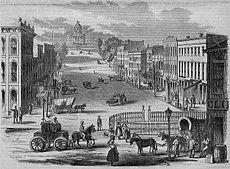
The Upper Creek were able to discourage most European-American immigration until after the conclusion of the Creek War. Following their defeat by General Andrew Jackson in August 1814, the Creek tribes were forced to cede 23 million acres to the United States, including remaining land in Georgia and most of central and southern Alabama. In 1816, the territory organized Montgomery County, and its lands were sold off the next year at the federal land office in Milledgeville, Georgia.
The first group of European-American settlers to come to the Montgomery area was headed by General John Scott. The group founded Alabama Town about 2 miles (3 km) downstream on the Alabama River from present-day downtown. In June 1818, county courts were moved from Fort Jackson to Alabama Town. Soon after, Andrew Dexter founded New Philadelphia, the present-day eastern part of downtown. He envisioned a prominent future for his town; he set aside a hilltop known as "Goat Hill" as the future sire of the state capitol building. New Philadelphia soon prospered, and Scott and his associates built a new town adjacent, calling it East Alabama Town. Originally rivals, the towns merged on December 3, 1819, and were incorporated as the city of Montgomery.
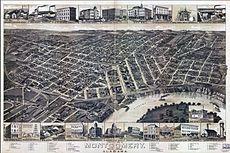
Driven by the revenues of the cotton trade, the newly united Montgomery grew quickly. In 1822, the city became the county seat. A new courthouse was built at the present location of Court Square, at the foot of Market Street (now Dexter Avenue). The state capital was moved from Tuscaloosa to Montgomery, on January 28, 1846.
As state capital, Montgomery began to influence state politics, and would also play a prominent role on the national stage. Beginning February 4, 1861, representatives from Alabama, Georgia, Florida, Louisiana, Mississippi, and South Carolina met in Montgomery to form the Confederate States of America. Montgomery was named the first capital of the nation, and Jefferson Davis was inaugurated as President on the steps of the State Capitol. On April 12, 1865, following the Battle of Selma, Major General James H. Wilson captured Montgomery for the Union.
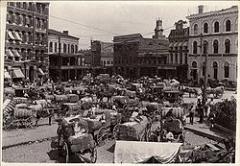
In 1886 Montgomery became the first city in the United States to install city-wide electric street cars along a system that was nicknamed the Lightning Route. The system made Montgomery one of the first cities to "depopulate" its residential areas at the city center through transit-facilitated suburban development.
According to the historian David Beito of the University of Alabama, African Americans in Montgomery "nurtured the modern civil rights movement." On December 1, 1955, Rosa Parks was arrested for refusing to give up her bus seat to a white man, sparking the Montgomery Bus Boycott. Martin Luther King, Jr., then the pastor of Dexter Avenue Baptist Church, and E.D. Nixon, a lawyer and local civil rights advocate, founded the Montgomery Improvement Association to organize the boycott. In June 1956, the US District Court Judge Frank M. Johnson ruled that Montgomery's bus racial segregation was unconstitutional. After the US Supreme Court upheld the ruling in November, the city desegregated the bus system, and the boycott was ended. Opponents organized mob violence with police collaboration at the Greyhound Bus Station during the Freedom Ride of May 1961. Outraged national reaction resulted in the desegregation of interstate public transportation.
Martin Luther King returned to Montgomery in 1965. Local civil rights leaders in Selma had been protesting Jim Crow laws that prevented blacks from registering to vote. Following the shooting of a man after a civil rights rally, the leaders decided to march to Montgomery to petition Governor George Wallace to allow free voter registration. The violence they encountered contributed to Congressional passage of the Voting Rights Act of 1965, to enforce the rights of African Americans and other minorities to vote.
In recent years, Montgomery has grown and diversified its economy. Active in restoring the downtown, the city adopted a master plan in 2007; it includes the revitalization of Court Square and the riverfront.
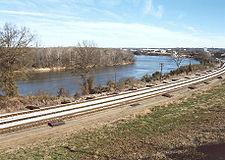
Montgomery is located at 32 °21 a²42 a³N 86 °16 a²45 a³W / 32.36167 °N 86.27917 °W / 32.36167; -86.27917. According to the U.S. Census Bureau, the city has a total area of 156.2 square miles (405 km2), of which 155.4 square miles (402 km2) of it is land and 0.8 square miles (2.1 km2) of it (0.52%) is water. The city is built over rolling terrain at an elevation of about 220 feet (67 m) above sea level

Downtown Montgomery lies along the southern bank of the Alabama River, about 6 miles (9.7 km) downstream from the confluence of the Coosa and Tallapoosa rivers. The most prominent feature of Montgomery's skyline is the 397 ft (121 m), RSA Tower, built in 1996 by the Retirement Systems of Alabama. Other prominent buildings include Regions Tower, and 8 Commerce Street. Downtown also contains many state and local government buildings, including the Alabama State Capitol. The Capitol is located atop a hill at one end of Dexter Avenue, along which also lies the Dexter Avenue Baptist Church, where Martin Luther King, Jr. was pastor. Both the Capitol and Dexter Baptist Church are listed as National Historic Landmarks by the U.S. Department of the Interior. Other notable buildings include RSA Dexter Avenue, RSA Headquarters, Alabama Center for Commerce, RSA Union, and the Renaissance Hotel and Spa.
One block south of the Capitol is the First White House of the Confederacy, the 1835 Italianate-style house in which President Jefferson Davis and family lived while the capitol of the Confederacy was in Montgomery. Montgomery's third National Historic Landmark is Union Station. Train service to Montgomery ceased in 1989, but today Union Station is part of the Riverwalk park development, which includes an amphitheater, a riverboat dock and Riverwalk Stadium. Three blocks east of the Convention Center, Old Alabama Town showcases more than 50 restored buildings from the 19th century. The Riverwalk is part of a larger plan to revitalize the downtown area and connect it to the waterfront. The plan includes urban forestry, infill development, and facade renovation to encourage business and residential growth. A 112,000-square-foot (10,400 m2) Convention Center, completed in 2007, is expected to encourage growth in the downtown area.
South of downtown, across Interstate 85, lies Alabama State University. ASU's campus was built in Colonial Revival architectural style from 1906 until the beginning of World War II. Surrounding ASU are the Garden District, and Cloverdale Historic District. Houses in these areas date from around 1875 until 1949, and are in Late Victorian and Gothic Revival styles. Huntingdon College is on the southwestern edge of Cloverdale. The campus was built in the 1900s in Tudor Revival and Gothic Revival styles. ASU, the Garden District, Cloverdale, and Huntingdon are all listed on the National Register of Historic Places as historic districts.
Montgomery's east side is the fastest-growing part of the city. The city's two largest shopping malls (Eastdale Mall and The Shoppes at Eastchase), as well as many big-box stores and residential developments are on the east side. The area is also home of the Wynton M. Blount Cultural Park, a 1-square-kilometer (250-acre) park which contains the Alabama Shakespeare Festival and Montgomery Museum of Fine Arts.
Prattville, located in Autauga County 10 miles (16 km) to the northwest, is the second-largest city in the Montgomery Metropolitan Area. Other area towns are Pike Road to the southeast, Millbrook to the north (Elmore County), and Wetumpka to the northeast (Elmore County).
Montgomery has a humid subtropical climate (Koppen Cfa), with short, mild winters, warm springs and autumns, and long, hot, humid summers. Winter temperatures average 46.6 °F (8.1 °C) in January, and lows rarely dip below 20 °F ( na6.7 °C). Summer temperatures average 81.8 °F (27.7 °C) in July, with highs exceeding 90 °F (32.2 °C) on 81 days per year and 100 °F (37.8 °C) on 3. Summer afternoon heat indices are frequently at or above 100 degrees. Differences between daytime and nighttime temperatures tend to be large in spring and autumn. Rainfall is well-distributed throughout the year, though January through March are the wettest, and October is significantly drier than the other months. Snowfall occurs only during some winters, and even then is usually light. Substantial snowstorms are rare, but do occur approximately once every 10 years. Extremes range from na5 °F ( na20.6 °C) on February 13, 1899 to 107 °F (41.7 °C) on July 7, 1881.
As of the 2010 census, the population of the city was 205,764. There were 81,486 households, out of which 29% had children under the age of 18 living with them. The racial makeup of the city was 56.6% Black, 37.3% White, 2.2% Asian, 0.2% Native American, 0.1% Pacific Islander, 2.2% from other races, and 1.3% from two or more races. 3.9% of the population were Hispanic or Latino of any race. Non-Hispanic Whites were 36.1% of the population in 2010, down from 66% in 1970.
The city population was spread out with 24.9% under the age of 18, 11.7% from 18 to 24, 27.3% from 25 to 44, 24.2% from 45 to 64, and 11.8% who were 65 years of age or older. The median age was 34 years. For every 100 females there were 88.6 males. For every 100 females age 18 and over, there were 84.5 males. The median income for a household in the city was $41,380, and the median income for a family was $53,125. Males had a median income of $40,255 versus $33,552 for females. The per capita income for the city was $23,139. About 18.2% of families and 21.6% of the population were below the poverty line, including 34.8% of those under age 18 and 8.4% of those age 65 or over.
Montgomery's central location in Alabama's Black Belt makes it a processing hub for crops such as cotton, peanuts, and soybeans. In 1840 Montgomery County led the state in cotton production, and by 1911, the city processed 160,000 ae200,000 bales of cotton annually. Montgomery has long had large metal fabrication and lumber production sectors. Due to its location along the Alabama River and extensive rail connections, Montgomery has and continues to be a regional distribution hub for a wide range of industries. Today, the city's Gross Metropolitan Product is $12.15 billion, representing 8.7% of the Gross State Product of Alabama.
According to Bureau of Labor Statistics data from October 2008, the largest sectors of non-agricultural employment were: Government, 24.3%; Trade, Transportation, and Utilities, 17.3% (including 11.0% in retail trade); Professional and Business Services, 11.9%; Manufacturing, 10.9%; Education and Health Services, 10.0% (including 8.5% in Health Care & Social Assistance); Leisure and Hospitality, 9.2%; Financial Activities, 6.0%, Natural Resources, Mining and Construction, 5.1%; Information, 1.4%; and Other services 4.0%. Unemployment for the same period was 5.7%, 2.5% higher than October 2007. The city also draws in workers from the surrounding area; Montgomery's daytime population rises 17.4% to 239,101.
As of January 2011, Montgomery's largest employers were Maxwell-Gunter Air Force Base (12,280 employees), the State of Alabama (9,500), Montgomery Public Schools (4,524), Baptist Health (4,300), Hyundai Motor Manufacturing Alabama (2,700), Alfa Insurance (2,568), the City of Montgomery (2,500), Jackson Hospital & Clinic (1,300), Rheem Water Heaters (1,147), and Regions (977).
According to Pennsylvania State University's "Living Wage Calculator", the living wage for the city is US$8.02 per hour (or $16,691 per year) for an individual and $25.80 per hour ($53,662 per year) for a family of four. These are slightly higher than the state averages of $7.45 per hour for an individual and $25.36 for a family of four.
Montgomery operates under a Mayor aecouncil government system. The mayor and council members are elected to four-year terms. The current mayor is Todd Strange, who was elected mayor in a special election, held March 10, 2009, after then-mayor Bobby Bright was elected to U.S. Congress for the 2nd district. The city is served by a nine-member city council, elected from nine districts of equal size.
As the seat of Montgomery County, the city is the location of county courts and the county commission. Montgomery is the capital of Alabama, and hosts numerous state government offices, including the office of the Governor, the Alabama Legislature, and the Alabama Supreme Court.
At the federal level, the majority of Montgomery is part of the 2nd U.S. Congressional district, currently represented by Republican Martha Roby. Roby defeated former Montgomery mayor Bobby Bright in the 2010 elections. Some of the southern and eastern portions of the city are part of the 3rd district, represented by Republican Mike Rogers.
Despite its reputation, Montgomery's crime rates compare favorably to other large cities in the state. In 2009 Montgomery's violent crime rate was 429.4 per 100,000, well below Birmingham, Huntsville, and Mobile, below the state average, and similar to the national average. For property crimes, Montgomery's average is similar to Alabama's other large cities, but higher than the overall state and national averages.
The Wynton M. Blount Cultural Park in east Montgomery is home to the Montgomery Museum of Fine Arts. The Museum's permanent collections include American art and sculpture, Southern art, master prints from European masters, and collections of porcelain and glass works. The Society of Arts and Crafts operates a co-op gallery for local artists. Montgomery Zoo, one of only two AZA-accredited zoos in Alabama, has over 500 animals in 40 acres (0.16 km2) of barrier-free habitats. The Hank Williams Museum contains one of the largest collections of Williams memorabilia in the world.
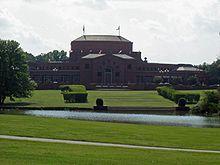
Blount Park also contains the Alabama Shakespeare Festival's Carolyn Blount Theatre. The Shakespeare Festival presents year-round performances of both classic plays and performances of local interest, in addition to works of William Shakespeare. The 1200-seat Davis Theatre for the Performing Arts, on the Troy University at Montgomery campus, opened in 1930 and was renovated in 1983. It houses the Montgomery Symphony Orchestra, Alabama Dance Theatre and Montgomery Ballet, as well as other theatrical productions. The Symphony has been performing in Montgomery since 1979. The Capri Theatre in Cloverdale was built in 1941, and today shows independent films. Jubilee CityFest is an annual music festival featuring a variety of performers.
There is a rich history of musical performers with roots in Montgomery. Jazz singer and pianist Nat King Cole, country singer Hank Williams, blues singer Big Mama Thornton, Melvin Franklin of The Temptations, and guitarist Tommy Shaw of Styx are among the many musicians to get their start in Montgomery. Author and artist Zelda Sayre was born in Montgomery. In 1918, she met F. Scott Fitzgerald, who was a soldier stationed at an Army post nearby. The house where they lived is today used as the F. Scott and Zelda Fitzgerald Museum. Poet Sidney Lanier lived in Montgomery and Prattville immediately after the Civil War, while writing his novel Tiger Lilies.
In addition to being the launching point of Hank Williams Sr. aos career, and the birthplace of Nat King Cole, Clarence Carter, and Tommy Shaw, Montgomery has also seen a few of its rock bands achieve national success in recent years. Locals artists Trust Company were signed to Geffen Records in 2002. Hot Rod Circuit formed in Montgomery in 1997 under the name Antidote, but achieved success with Vagrant Records after moving to Connecticut. The Ed Kemper Trio became well known in Montgomery aos local rock music scene from 1997 ae2004, and was the focus of People Will Eat Anything, a music documentary shown at the Capri Theatre in 2004.
Montgomery is home of the Montgomery Biscuits baseball team. The Biscuits play in the Class AA Southern League. They are affiliated with the Tampa Bay Rays, and play at Montgomery Riverwalk Stadium. Riverwalk Stadium was the host of the NCAA Division II National Baseball Championship from 2004 until 2007. The championship had previously been played at Paterson Field in Montgomery from 1985 until 2003.
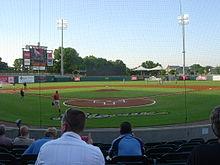
The Navistar LPGA Classic women's golf event is held at the Robert Trent Jones Golf Trail at Capitol Hill in nearby Prattville. Garrett Coliseum was the home of the now-defunct Montgomery Bears indoor football team.
Montgomery is also the site of sporting events hosted by the area's colleges and universities. The Alabama State University Hornets play in NCAA Division I competition in the Southwestern Athletic Conference (SWAC). The football team plays at Hornet Stadium, the basketball teams play at the Dunn-Oliver Acadome, and the baseball team plays at the ASU Baseball Complex, which recently opened on March 26, 2010. Auburn University at Montgomery also fields teams in NAIA competition. Huntingdon College participates at the NCAA Division III level and Faulkner University is a member of the NAIA and is a nearby rival of Auburn University at Montgomery. The Blue-Gray Football Classic was an annual college football all-star game held from 1938 until 2001. In 2009, the city played host to the first annual Historical Black College and University (HBCU) All-Star Football Bowl played at Cramton Bowl.
Several successful professional athletes hail from Montgomery, including Pro Football Hall of Famer Bart Starr and two-time Olympic gold medalist in track and field Alonzo Babers.
Montgomery has many active civic organizations including a number of organizations focused on diversity relations and the city's rich civil rights history. Leadership Montgomery provides citizenship training. The group One Montgomery was founded in 1983 and is a forum for networking of a diverse group of citizens active in civic affairs.
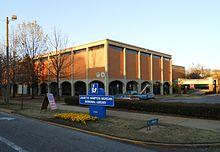
The city of Montgomery and Montgomery County are served by the Montgomery Public Schools system. As of 2007, there were 32,520 students enrolled in the system, and 2,382 teachers employed. The system manages 32 elementary schools, 10 middle schools, and 4 high schools (G.W. Carver, Jeff Davis, Robert E. Lee, and Sidney Lanier) as well as 9 magnet schools, 1 alternative school, and 2 special education centers. Montgomery is also home to 28 private schools. In 2007, Forest Avenue Academic Magnet Elementary School was named a National Blue Ribbon School. In 2008 Loveless Academic Magnet Program (LAMP) High School was named No. 20 on U.S. News & World Report's Gold Medal List, a nationwide ranking, bringing national attention to the city.
The Montgomery City-County Public Library operates public libraries.
The city is also home to Alabama's oldest law library, the Supreme Court and State Law Library, founded in 1828. Located in the Heflin-Torbert Judicial Building, the Law Library owns a rare book collection considered as one of the finest in the Southeast, containing works printed as early as 1605.
Montgomery has been the home of Alabama State University, a historically black university, since the Lincoln Normal University for Teachers relocated from Marion in 1887. Today, ASU enrolls over 5,600 students from 42 U.S. states and 7 countries. The public Troy University maintains a 3,000 student population campus in downtown Montgomery that prominently houses the award-winning Rosa Parks Library and Museum. Troy University is also a worldwide leader in distance learning programs. Another public institution, Auburn University at Montgomery, with an enrollment of 5,123, is in the eastern part of the city and operates as a satellite campus of Auburn University.
Montgomery also is home to several private colleges: Faulkner University, which has an enrollment of 3,500, is a Church of Christ-affiliated school; Huntingdon College, which has a current student population of 1,000 and is affiliated with the United Methodist Church; Virginia College and Amridge University.
Several two-year colleges also have campuses in Montgomery, including H. Councill Trenholm State Technical College
Maxwell Air Force Base is the headquarters for Air University, the United States Air Force's center for professional military education. Branches of Air University based in Montgomery include the Squadron Officer School, the Air Command and Staff College, the Air War College, and the Community College of the Air Force.
The morning newspaper, the Montgomery Advertiser, began publication as The Planter's Gazette in 1829. It is the principal newspaper of central Alabama and is affiliated with the Gannett Corporation. In 1970, then publisher Harold E. Martin won the Pulitzer Prize for special reporting while at the Advertiser. The Alabama Journal was a local afternoon paper from 1899 until April 16, 1993, when it published its last issue before merging with the morning Advertiser.
Montgomery is served by seven local television stations: WNCF 32 (ABC), WSFA 12 (NBC), WCOV 20 (Fox), WBMM 22 (CW), WAIQ 26 (PBS), WMCF 45 (TBN), WFRZ-LD 34 (Religious and Educational). In addition, WAKA 8 (CBS) and WBIH 29 (independent) are located in Selma, and WIYC 67 (AMV) is licensed to Troy. Montgomery is part of the Montgomery-Selma Designated Market Area (DMA), which is ranked 118th nationally by Nielsen Media Research. Charter Communications and Knology provide cable television service. DirecTV and Dish Network provide direct broadcast satellite television including both local and national channels to area residents.
The Montgomery area is served by nine AM radio stations: WMSP, WMGY, WNZZ, WTBF, WGMP, WAPZ, WIQR, WLWI, and WXVI; and nineteen FM stations: WJSP, WAPR, WELL, WLBF, WTSU, WVAS, WLWI, WXFX, WQKS, WWMG, WVRV, WJWZ, WBAM, WALX, WHHY, WMXS, WHLW, WZHT, and WMRK. Montgomery is ranked 154th largest by Arbitron.
Two major motion pictures have been filmed in Montgomery: The Long Walk Home, set during the Montgomery Bus Boycott, and Big Fish, partially shot at Huntingdon College.
Two interstate highways run through Montgomery. Interstate 65 is the primary north aesouth freeway through the city leading between Birmingham and Huntsville to the north and Mobile to the south. Montgomery is the southern terminus of Interstate 85, another north aesouth freeway (though running east aewest in the city), which leads northeast to Atlanta. The major surface street thoroughfare is a loop consisting of State Route 152 in the north, U.S. Highway 231 and U.S. Highway 80 in the east, U.S. Highway 82 in the south, and U.S. Highway 31 along the west of the city. The Alabama Department of Transportation is planning the Outer Montgomery Loop to ease traffic congestion in the city. It is planned to connect Interstate 85 near Mt. Meigs to U.S. Highway 80 southwest of the city. Upon completion of the loop, it will carry the I-85 designation while the original I-85 into the city center will be redesignated I-685. Montgomery Area Transit System (MATS) provides public transportation with buses serving the city. The system has 32 buses providing an average of 4500 passenger trips daily. MATS ridership has shown steady growth since the system was revamped in 2000; the system served over 1 million passenger trips in 2007. Greyhound Lines operates a terminal in Montgomery for intercity bus travel.
Montgomery Regional Airport, also known as Dannelly Field, is the major airport serving Montgomery. It serves primarily as an Air National Guard base and for general aviation, but commercial airlines fly to regional connections to Atlanta, Dallas-Fort Worth, Charlotte, and Memphis.
Passenger rail service to Montgomery was enhanced in 1898 with the opening of Union Station. Service continued until 1979, when Amtrak terminated its Floridian route. Amtrak returned from 1989 until 1995 with the Gulf Breeze, an extension of the Crescent line.
Montgomery has one sister city:
Word Count: 7109






